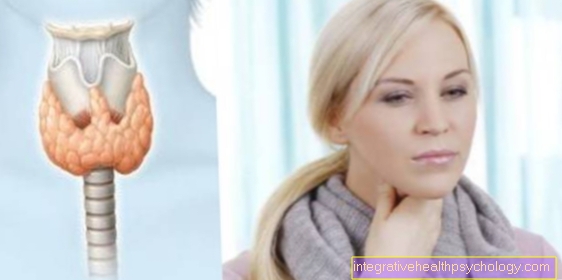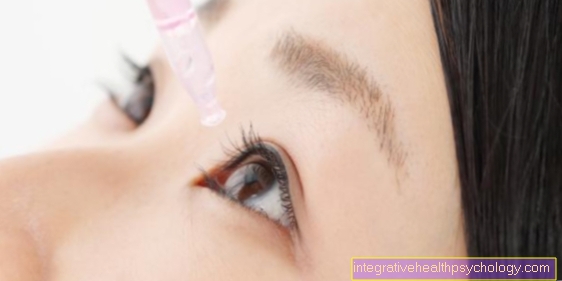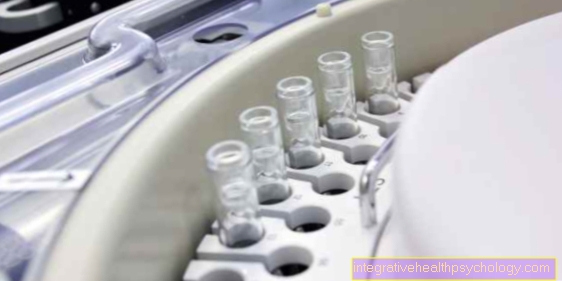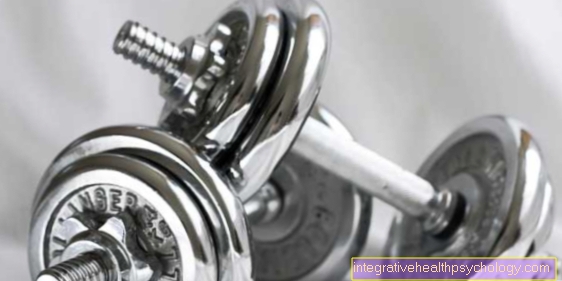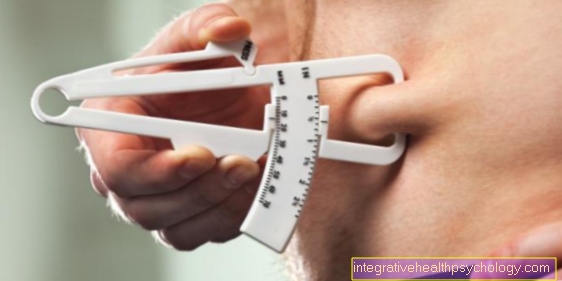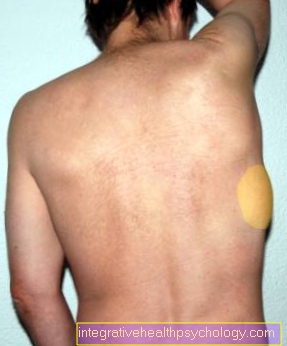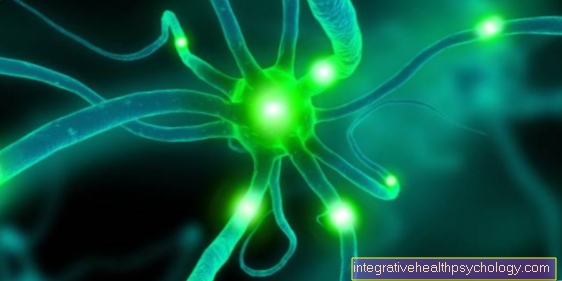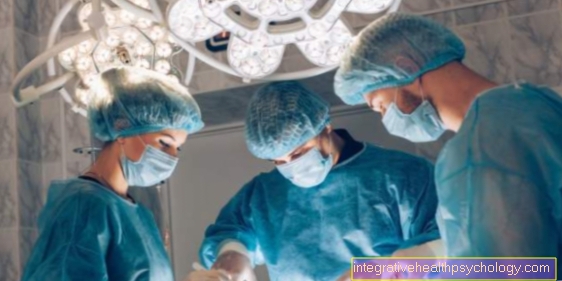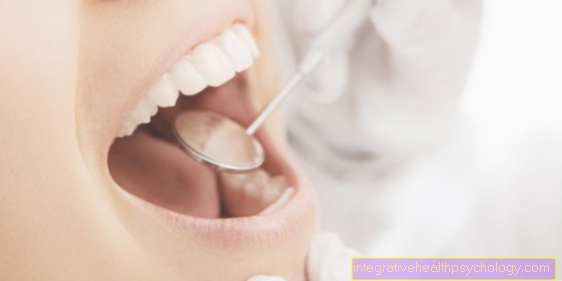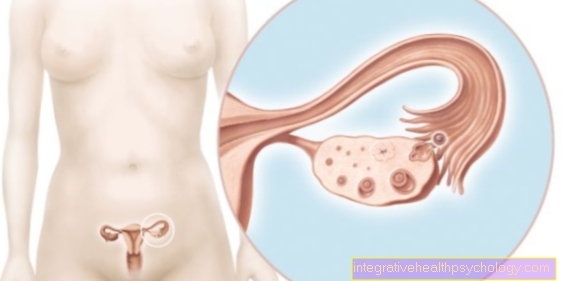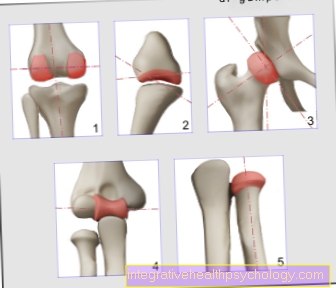Chromosome mutation
Definition - what is a chromosome mutation?
The human genome, i.e. the entirety of genes, is divided into chromosomes. Chromosomes are very long DNA chains that can be distinguished from one another in the metaphase of cell nucleus division. The genes are arranged on the chromosomes in a fixed order.
With chromosome mutations there are microscopically visible changes in this sequence, which are caused by relatively large damage to the chromosomes. A distinction can be made between different forms of this type of damage. Some forms go undetected, but others cause serious clinical pictures. Which disease develops depends on the type of damage and on which chromosome it is located.

Causes - why do they arise?
Chromosome mutations arise in half of the people affected by mutations that have arisen “de novo”. De novo means that the mutation only arose in the germ cells of the parents, i.e. egg or sperm cells.
Certain poisons can cause chromosome mutations. These so-called clastogens cause the chromosomes to break, causing the various forms of chromosome mutations.
Humans have two types of chromosomes, a maternal and a paternal one. When the germ cell is formed, the maternal and paternal genetic makeup is mixed up. This process is called "crossing over".
Normally there is only mixing between chromosomes of the same type. In the case of chromosome mutations, this crossing-over is faulty. In addition, parts of a chromosome are incorporated into a chromosome that is not of the same type. In addition, chromosome parts can be incorporated upside down. In some cases, however, a section of the chromosome in a germ cell is completely lost.
How do you recognize a chromosome mutation?
If there are malformations or mental retardation, chromosome analyzes can be carried out to confirm a genetic cause. In order to carry out a chromosome analysis, cells are removed from the affected person in order to examine the chromosomes of these.
Lymphocytes, i.e. cells of the immune defense that circulate in the blood, are most frequently used for the analysis. In principle, however, all cells can be used that have a cell nucleus.
Chromosome mutations are associated with changes, some of which can be seen under the light microscope. The different chromosomes have a very specific shape.
In addition, a special technique enables the chromosomes to be stained. With this coloration, so-called bands develop. By identifying the specific bands, it can be determined which of the 23 pairs of chromosomes is involved. This banding technique can also be used to detect changes in the respective chromosomes.
Which chromosome mutations are there?
In the case of chromosome mutations, a distinction is made between different forms of mutation.
A section of the chromosome was lost in the deletion. The affected chromosome is shortened at the corresponding point. In the case of deletion, genes are lost; the effects can vary depending on the section.
In contrast to deletion, insertion involves the insertion of a chromosome segment into another chromosome. If the segment originates in another cell nucleus, the genes in this segment are duplicated. There may be an overproduction of the gene product.
In inversion, a section is in the correct chromosome, but in the reverse order.
There can also be a duplication, in which case part of the chromosome is duplicated.
The most important chromosome mutation is the translocation. Here chrosomome parts of 2 different chromosomes swap their places. If this exchange is not accompanied by a loss of genes, one speaks of one balanced Translocation. Carriers of balanced translocations usually do not show any abnormalities, but they have more frequent miscarriages. In addition, the offspring are often carriers more unbalanced Translocations. In these, genetic material is lost and the offspring are restricted.
- Find out which changes in DNA besides mutations are common at: Epigenetics
What is a reciprocal translocation?
In reciprocal translocation, parts of two different chromosomes are exchanged between them. With reciprocal translocation it is important that the total content of the genetic material in the cell remains the same.
However, those affected have problems with the formation of germ cells. If there is a chromosome in the developing germ cell, in which a piece has been exchanged, then this cell is not viable.
However, it can also be the case that the two chromosomes in which a piece has been exchanged end up in a germ cell. Then only the normal chromosomes end up in the other germ cell that is formed. If this is the case, only half of the germ cells are unable to survive. The other half contains a normal set of chromosomes.
Reciprocal transocation can lead to a variety of genetic diseases. One before that, for example, is Chronic Myeloid Lekemia, where a high number of Philadelphia chromosomes can be detected.
Cat Scream Syndrome
The cat cry syndrome, or Cri-du-Chat syndrome, is so called because the toddlers scream very high up and like cats. These high-pitched screams are caused by a malformation of the larynx. The cause of the cat cry syndrome is a deletion on the short arm of chromosome 5.
Those affected are severely retarded and mentally handicapped. Intellectual disability, however, is very variable. They have a small head and their growth is disturbed. There are also other physical malformations. Changes in the internal organs are very rare. Life expectancy is therefore not significantly restricted.
Read more on the subject at: Cat Scream Syndrome
What is chromosomal aberration?
Chromosome aberration is a change in the chromosomes that is visible under a light microscope. In contrast, there are gene mutations, these changes are much smaller and can only be recognized through more precise genetic diagnostics.
Chromosome aberrations can be divided into two forms. There are structural and numerical aberrations. The structural aberrations were discussed in this chapter and are also called chromosome mutations. They are accompanied by a change in the chromosomes themselves.
Numeric aberration means that there is an incorrect number of chromosomes. The normal human karyotype, i.e. the number of chromosomes, is 46, XY in men and 46, XX in women. It must be noted that the chromosomes are duplicated, the only exception being the sex chromosomes in men. The sex chromosomes, which represent the only difference in the genome in men and women, are indicated by the letters.
In numerical aberrations, chromosomes may appear more frequently or be absent. The best-known example is Down's syndrome, trisomy 21, the name implies that the 21st chromosome is present three times instead of in duplicate. The karyotype of a person looks like this: 47, XY + 21 for men and 47, XX + 21 for women.
An example of the lack of a chromosome is Turner syndrome or monosomy X, in this case an X chromosome is missing, resulting in karyotype 45, X0. The people affected are women with certain physical abnormalities.
You can find out more about this topic at: Chromosome aberration - what is it?
Klinefelter Syndrome
Klinefelter syndrome is not a chromosomal mutation. Chromosome mutations are accompanied by a change in structure. The wrong number of chromosomes is present in Klinefelter syndrome. This change is called numerical chromosomal aberration.
Klinefelter syndrome can only affect men. Normally men have in addition to the 44 other chromosomes (22 chromosomes, each in two copies), one X chromosome and one Y chromosome. In Klinefelter syndrome, there is one X chromosome too many.
This change has the greatest impact on the genital organs. Those affected have small testicles and, in most cases, no functioning sperm production, and testosterone production is limited.
The Klinefelter syndrome is often only discovered in the context of a fertility counseling.In the vast majority of those affected, it goes undetected. Breast development can occur during puberty, and body hair is usually only sparse. However, those affected are not restricted in their intelligence.
Further information on this topic can be found at: Klinefelter Syndrome
What is a point mutation?
In the case of a point mutation, one speaks of a mutation of the genes that are present in the form of DNA. The DNA is made up of four different nucleotides. In the case of a point mutation, one nucleotide is exchanged for another. The DNA of the genes is read in a complex process. The end product of this process is a protein.
Which protein is produced is essentially determined by the sequence of nucleotides. Three consecutive nucleotides determine which amino acid is attached to the resulting protein chain. The amalgamation of a large number of amino acids then becomes a protein.
But if one nucleotide is replaced by another, it can happen that a different amino acid is incorporated into the protein. The result is a so-called missense mutation. The resulting protein can remain fully functional by replacing the amino acid or it can also lose its function.
Another possibility is to incorporate a so-called stop codon. Such type of mutation is known as the nonsense mutation. The stop codon marks the end of the protein; if it is inserted in the wrong place, the protein is incomplete.
With these forms of point mutations, the number of nucleotides to be read remains the same. The correct amino acids are incorporated before and after the point mutation. The “reading grid” is therefore retained. Mutations in which a nucleotide is incorporated or removed, i.e. insertion or deletion, are more serious. With this mutation, after the missing or built-in nucleotide, three other nucleotides are combined, which means that different amino acids are built in and a completely different protein is created.
Our next article could also be of interest to you: Telomeres - Anatomy, Function & Diseases
Cystic fibrosis
Cystic fibrosis is a disease that results from a mutation in a chloride channel. These channels are important for the formation of mucus in the body, as water can escape following the chloride, making the mucus thinner.
Although all organ systems are affected by this disease, the lungs are in the foreground. The viscous mucus prevents the lungs from performing their self-cleaning function.
A thin fluid mucus is the prerequisite for the removal of pathogens and other substances from the lungs. The lack of cleaning leads to increased pneumonia. This is one of the reasons why those affected have a drastically reduced life expectancy.
The mutation of the channel is due to a gene mutation. This means that the sequence of the components of the DNA within the gene has changed. The mutation is much smaller than chromosome mutations, but with very serious consequences. Hundreds of different mutations of the gene are known, all of which lead to dysfunction of the channel.
Read more about this under: Cystic fibrosis
Recommendations from the editorial team
You can read more information on the subject of "chromosome mutations" here:
- DNA
- Cell nucleus division
- Cell nucleus
- Down syndrom
- Klinefelter Syndrome
- Duchenne muscular dystrophy

